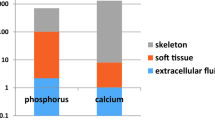Abstract
To examine whether there were gender differences in the sino-atrial node (SAN), the authors investigated the gender difference in the SAN using monkey hearts by direct chemical analysis from a viewpoint of element contents. The used rhesus and Japanese monkeys consisted of 30 males (average age = 6.5 ± 7.5 years) and 30 females (average age = 12.2 ± 10.3 years), ranging in age from newborn to 30 years. The SAN tissues were removed from the anatomical position of monkey hearts and were confirmed by means of histological observation. After ashing with nitric acid and with perchloric acid, element contents of the SANs, such as Ca, P, S, Mg, Zn, Fe, and Na, were determined by inductively coupled plasma-atomic emission spectrometry. In addition, gender differences in the right atrial walls, left ventricular walls, mitral valves, and left coronary arteries of monkeys were also investigated as controls. It was found that the P content was significantly higher in females than in males in the SANs of monkeys, but the other six element contents, Ca, S, Mg, Zn, Fe, and Na, were not significantly different between males and females in the SANs of monkeys. Regarding the P content, a similar finding was also obtained in both the right atrial walls and the left ventricular walls of monkeys, but it was not obtained in the mitral valves and the left coronary arteries of monkeys. The P content of tissue is mostly determined by the nucleic acid (DNA and RNA) content and the phospholipid content of tissue. Nucleic acids in the cell nucleus and the cytosol, and phospholipids in the cell membrane are all indicators of metabolically active cells. It is reasonable to presume that the P content in the SAN indicates the active cell density, namely, the number of active cells per volume. Therefore, there is a possibility that the active cell density of the SAN is significantly higher in females than in males.







Similar content being viewed by others
References
Crasset V, Mezzetti S, Antoine M et al (2001) Effects of aging and cardiac denervation on heart rate variability during sleep. Circulation 103:84–88
Di Gennaro M, Bernabei R, Sgadari A et al (1987) Age-related differences in isolated rat sinus node function. Basic Res Cardiol 82:530–536
Satoh H (2003) Age-dependent effects induced by ouabain in rat heart muscles and cellular Ca2+ concentration. Biol Trace Elem Res 92:151–159
Sanjeev S, Karpawich PP (2005) Developmental changes in sinus node function in growing children: an updated analysis. Pediatr Cardiol 26:585–588
Taneja T, Mahnert BW, Passman R et al (2001) Effects of sex and age on electrocardiographic and cardiac electrophysiological properties in adults. Pacing Clin Electrophysiol 24:16–21
Bin L, Yixuan S, Jiazhen Z et al (1995) Computerized microimage analysis of age-related changes of the human sinoatrial node. Forens Sci Int 75:149–155
Satoh H, Tohno S, Azuma C et al (2005) Age-related attenuation in the elements in monkey sino-atrial node. Biol Trace Elem Res 107:43–51
Tohno S, Tohno Y, Azuma C et al (2006) Decreases of calcium and phosphorus in monkey cardiac walls with development and aging. Biol Trace Elem Res 110:233–249
Menetti F, Tohno S, Tohno Y et al (2005) Age-dependent decreases of calcium, phosphorus, sulfur, and zinc in the cardiac valves of monkeys. Biol Trace Elem Res 106:231–245
Tohno Y, Tohno S, Laleva L et al (2008) Age-related changes of elements in the coronary arteries of monkeys in comparison with those of humans. Biol Trace Elem Res 125:141–153
Satoh H, Seyama I (1986) On the mechanism by which changes in extracellular pH affect the electrical activity of the sino-atrial node. J Physiol Lond 381:181–191
Satoh H, Uchida T (1993) Morphological and electrophysiological changes induced by calcium ionophores (A23187 and X-537A) in spontaneously beating rabbit sino-atrial node cells. Gen Pharmacol 24:49–57
Tohno Y, Tohno S, Minami T et al (1996) Age-related changes of mineral contents in human thoracic aorta and in the cerebral artery. Biol Trace Elem Res 54:23–31
Shiraishi I, Takamatsu T, Minamikawa T et al (1992) Quantitative histological analysis of the human sinoatrial node during growth and aging. Circulation 85:2176–2184
de Melo SR, de Souza RR, Mandarim-de-Lacerda CA (2002) Stereologic study of the sinoatrial node of rats—age related changes. Biogerontology 3:383–390
Yanni J, Tellez JO, Sutyagin PV et al (2010) Structural remodelling of the sinoatrial node in obese old rats. J Mol Cell Cardiol 48:653–662
Frausta da Silva JJR, Williams RJP (1991) The biological chemistry of the elements. Clarendon, Oxford
Oster O, Dahm M, Oelert H et al (1989) Concentrations of some trace elements (Se, Zn, Cu, Fe, Mg, K) in blood and heart tissue of patients with coronary heart disease. Clin Chem 35:851–856
Accili EA (1997) Properties and modulation of IF in newborn versus adult cardia SA node. Am J Physiol 272:H1549–H1552
Satoh H, Sperelakis N (1991) Identification of hyperpolarization-activated inward current in embryonic chick heart myocytes. J Dev Physiol 15:247–252
Satoh H, Sperelakis N (1995) Identification of and developmental changes in transient outward current in embryonic chick cardiomyocytes. Reprod Fertil Dev 7:1369–1374
Protas L, DiFrancesco D, Robinson RB (2001) L-type but not T-type calcium current changes during postnatal development in rabbit sinoatrial node. Am J Physiol 281:H1252–H1259
Costello RB, Moser-Veillon PB (1992) A review of magnesium intake in the elderly. A cause for concern? Mag Res 5:61–67
Olivetti G, Giordano G, Corradi D et al (1995) Gender differences and aging: effects on the human heart. J Am Coll Cardiol 26:1068–1079
Acknowledgment
This work was supported by the Cooperation Research Program (2005–2009) of Primate Research Institute, Kyoto University.
Author information
Authors and Affiliations
Corresponding author
Rights and permissions
About this article
Cite this article
Tohno, Y., Tohno, S., Satoh, H. et al. Gender Differences in the Phosphorus Content of the Sino-atrial Nodes and Other Cardiac Regions of Monkeys. Biol Trace Elem Res 143, 871–881 (2011). https://doi.org/10.1007/s12011-010-8908-6
Received:
Accepted:
Published:
Issue Date:
DOI: https://doi.org/10.1007/s12011-010-8908-6




